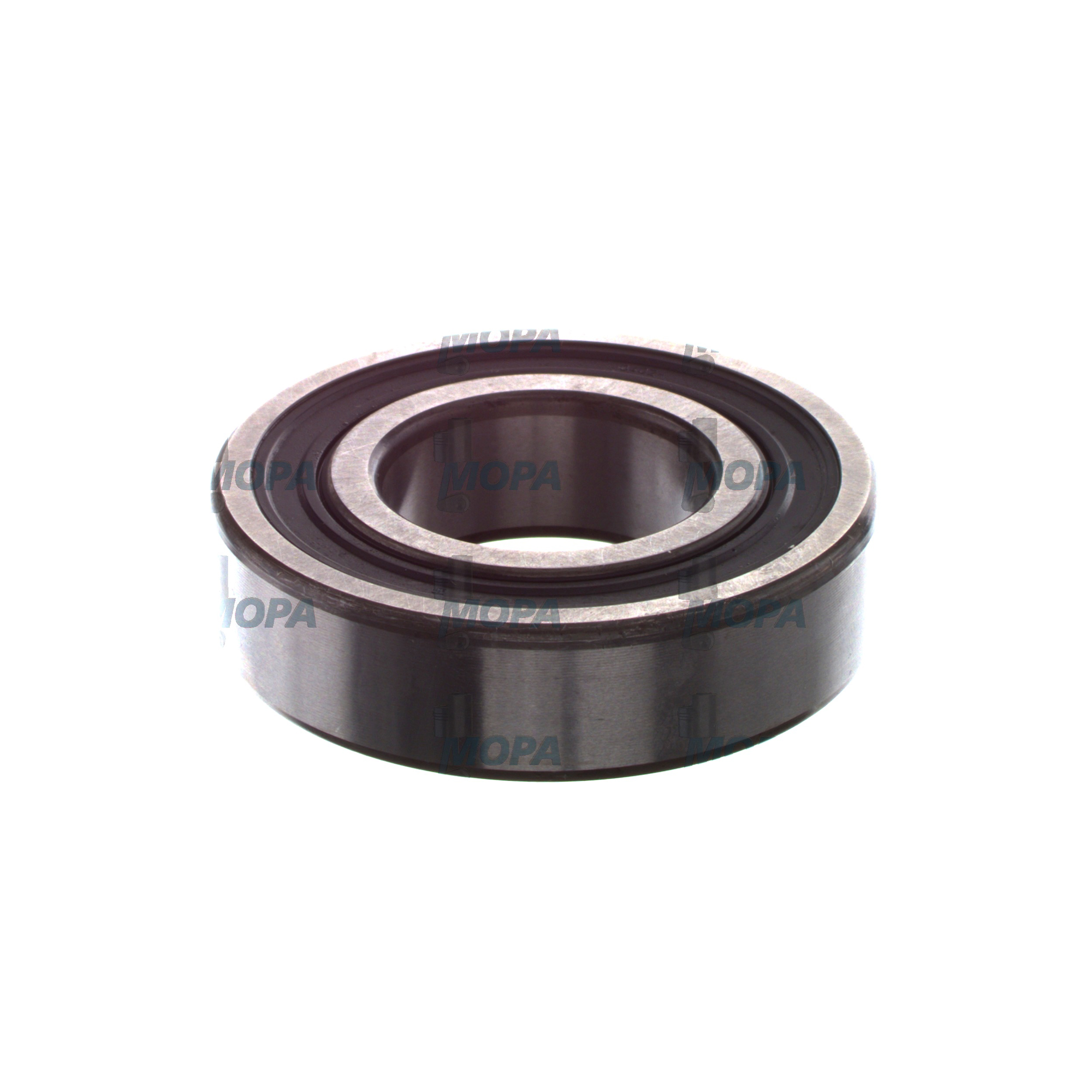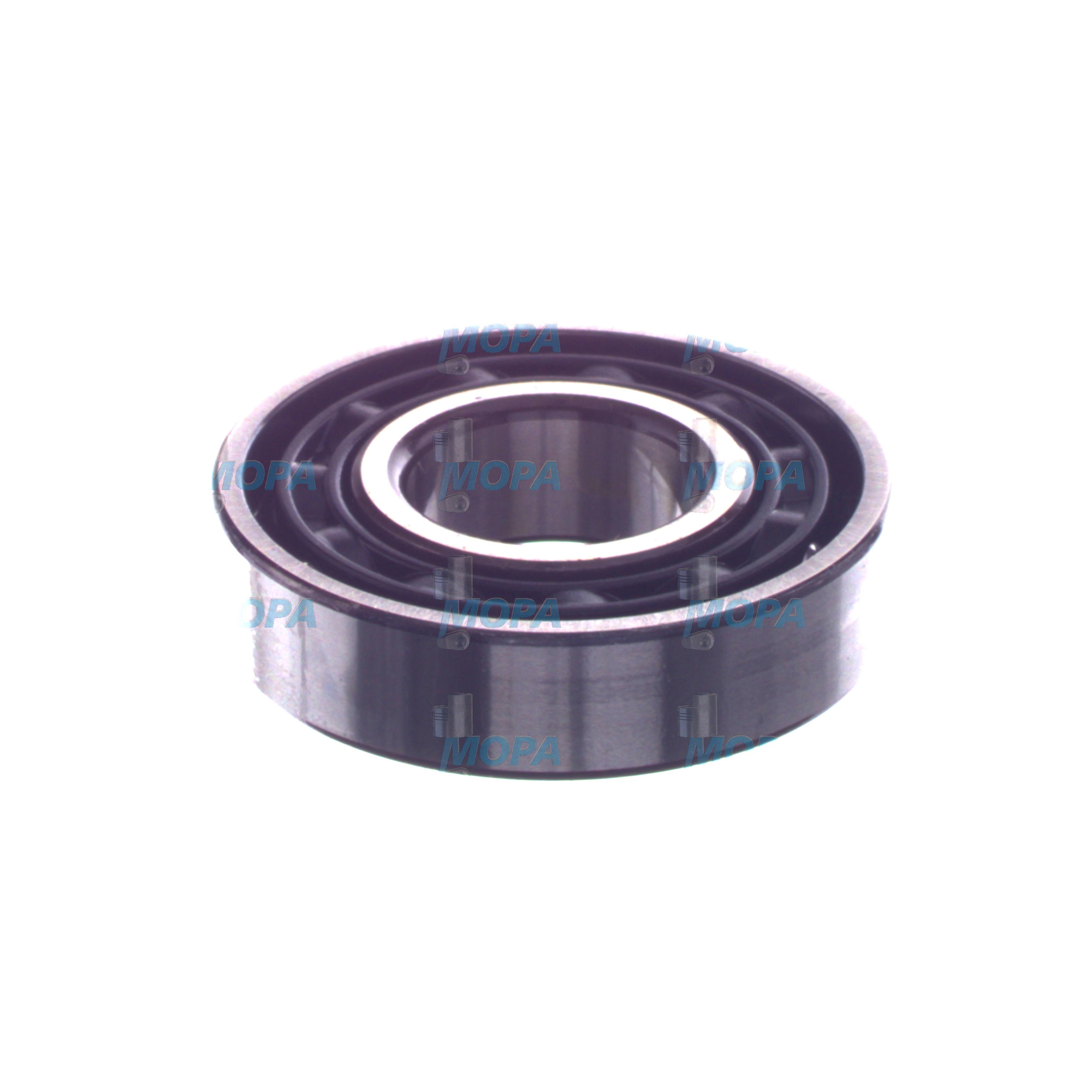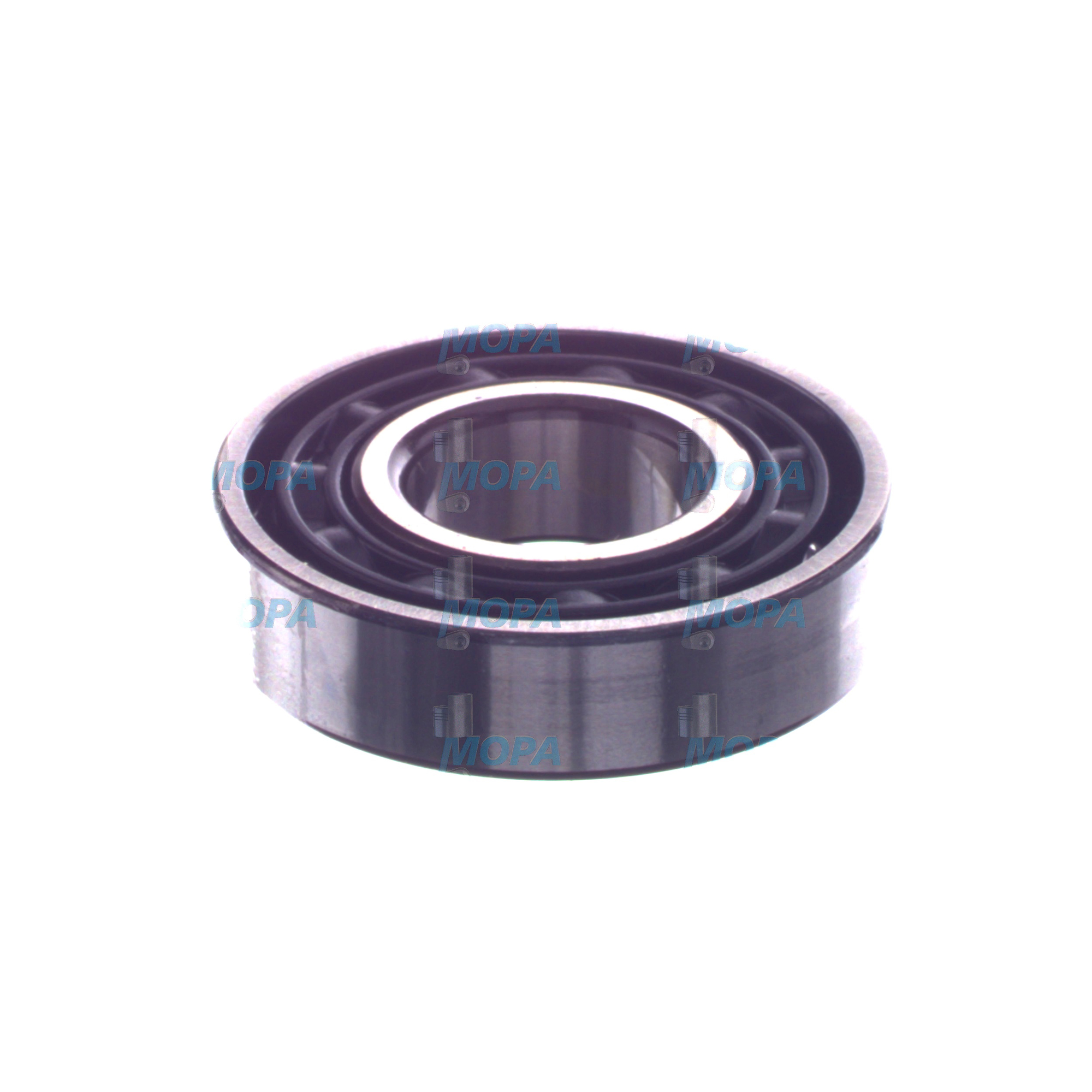BALL BEARING
BALL BEARING Bearings for high‑duty marine and diesel engines
Bearings are precision components that support rotating and oscillating parts, minimize friction, and carry radial and axial loads throughout an engine and its auxiliaries. In large marine and diesel engines, bearings sit at the heart of crankshafts, camshafts, gear trains, turbochargers, pumps, alternators, and compressors. Whether as rolling elements (such as a BALL BEARING) or plain/hydrodynamic designs, they stabilize motion, maintain alignment, and enable efficient power transfer—making them indispensable for uptime, efficiency, and safety at sea and on land.
Within the category of Bearings, BALL BEARING designs are common wherever low friction, precise guidance, and compact dimensions are required, for example in alternators, coolant pumps, electric motors, and certain turbocharger concepts. Their geometry—inner/outer raceways, balls, cage, and seals—delivers low rolling resistance and controlled heat generation, which directly supports fuel efficiency and component life in diesel engine applications.
Technical function of Bearings with a focus on BALL BEARING engine applications
In engines, Bearings provide accurate shaft support, translate combustion forces into rotation with minimal losses, and protect mating parts from wear. Rolling Bearings, such as a BALL BEARING diesel engine auxiliary bearing, use point contact between balls and raceways to achieve low friction at a broad speed range. Compared with plain bearings, they can start under lower breakaway torque and maintain dimensional stability even during repeated thermal cycles—a key advantage in frequent start–stop or variable-load operations.
In marine environments, a BALL BEARING marine engine pump or alternator bearing must withstand vibration, salt-laden humidity, and transient loads. The cage (often brass or polyamide), heat-treated races, and precision balls manage load paths while distributing lubricant. Sealing systems (2RS elastomer seals, ZZ shields, or open designs in lubricated housings) control contamination ingress and grease retention. Clearance classes (e.g., C3/C4 for higher operating temperatures) and tolerance grades to ISO 492 (e.g., P6/P5) ensure the correct running accuracy for vibration-sensitive components like generators.
Where speed and temperature rise quickly—such as in turbocharger center sections—engineers may choose specialized ceramic-hybrid BALL BEARING OEM parts or alternative bearing systems. Correct preload, fit tolerances (k/h/g), and shaft/housing finish are critical for low noise, low heat, and stable film formation. Proper lubrication (grease type, base oil viscosity, thickener, and additive package) safeguards against scuffing and micro-pitting, while alignment and balance protect against false brinelling during transport and operation.
- · Low friction and efficient power transfer.
- · High running accuracy and reduced vibration.
- · Configurable seals/shields for harsh environments.
- · Clearance classes matched to operating temperature.
- · Robust cages for high speed and load stability.
- · Proven metallurgy and heat treatment for long life.
- · Easy condition monitoring via vibration and temperature.
Why Bearings are crucial for engine reliability and service life
Bearings protect high-value components—shafts, gears, rotors—by maintaining the correct oil film or rolling contact conditions. When bearings drift out of specification, friction and temperature rise, alignment deteriorates, and the entire drivetrain becomes vulnerable. Typical failure mechanisms include contamination-induced wear, lubricant starvation, corrosion, electric erosion in generators, cage fracture, spalling from overloading, and false brinelling from vibration at standstill.
Consequences can be severe: increased fuel consumption from higher mechanical losses, unplanned shutdowns due to seizure, collateral damage to housings and shafts, imbalance in rotating equipment, and safety risks if failures propagate. Routine monitoring—acoustic/vibration analysis, infrared temperature trending, grease condition checks, and visual inspection of seals—helps extend the life of BALL BEARING marine engine auxiliaries and main engine Bearing sets alike.
Advantages of OEM spare parts suitable for Bearings
Using OEM spare parts that are suitable for Bearings ensures the precise geometry, surface finish, and material specification originally engineered for the engine platform. That alignment matters for load distribution, heat management, and vibration control—especially in high-output diesel and gas engines where tolerances are tight and service windows are short.
OEM Bearings and BALL BEARING OEM parts bring measurable advantages across your operation:
- · Performance: Consistent tolerances (e.g., ISO P6/P5) for smooth, quiet running.
- · Reliability: Correct steel grade, heat treatment, and cage design for the duty cycle.
- · Budget: Longer service life and predictable overhaul intervals reduce total cost.
- · Service life: Validated sealing and lubrication specs protect against contamination.
- · Compliance: Documentation and traceability for class and audit requirements.
- · Fit and function: Correct internal clearance (C3/C4) and preload options for temperature and speed.
By matching the exact specification—dimension series, bore/housing fits, seal type, lubricant fill, and clearance—you mitigate installation risk and avoid premature wear or vibration issues that can arise from mismatched parts. For sensitive applications such as a BALL BEARING OEM parts selection in a marine engine alternator or pump, this precision preserves efficiency and protects connected equipment.
MOPA: experienced partner for OEM Bearings and BALL BEARING diesel engine parts
MOPA supplies OEM spare parts for Bearings with a focus on speed, quality, and security in the trade of OEM parts for diesel and gas engines. Our network enables rapid sourcing of BALL BEARING OEM parts for marine engine auxiliaries, main engine applications, and power generation sets—backed by rigorous incoming inspection, batch traceability, and clear documentation.
We help purchasers and technical teams specify the correct bearing type (ball, cylindrical, tapered, thrust), clearance class, seal configuration, and lubricant fill to match the duty cycle and ambient conditions. From emergency deliveries to planned dry-dock refits, MOPA streamlines procurement, reduces downtime risk, and supports reliable, energy-efficient operation across your fleet or plant.
Conclusion: Bearings and the value of OEM spare parts
Bearings—especially the versatile BALL BEARING used in diesel engine and marine engine auxiliaries—are central to efficiency, safety, and long service life. Correct selection, lubrication, and monitoring keep critical equipment running smoothly.
Choosing OEM spare parts suitable for Bearings secures performance, reliability, and predictable lifecycle costs. With MOPA as your partner, you gain fast access to quality-assured components that protect your engines and your schedule.

Robustness of the Ball Bearing for Your EnginesDiscover our ball bearing, the ideal product suitable for MWM & Deutz engines. With a thoughtful design, this replacement part offers reliable performance and robustness that is crucial for diesel and gas engines. Weighing only 0.055 kg, this ball bearing represents an ideal combination of efficiency and durability.Precision Manufacturing to the Highest StandardsOur ball bearing, comparison number 606904010101, undergoes strict controls to ensure the quality of the OEM replacement parts. This ensures that the product, suitable for MWM & Deutz engines, can fulfill its purpose for a long time. Customers who rely on performance have made the right choice with comparison number 606904010101.

Precise Ball Bearing for MWM & DeutzDiscover the ball bearing with the comparison number 01108936, an essential component for diesel and gas engines. This product belongs to the category of OEM spare parts, specifically designed for high demands in industrial applications. Weighing only 0.089 kg, this ball bearing offers unmatched precision and efficiency.

1. Exquisite Ball Bearing: Your Solution!Discover our quality product, the ball bearing (comparison number: 200702930201), suitable for MTU engines. As an OEM replacement part, it offers durability and reliability to enhance the efficiency of your engines.2. Reliable OEM Replacement Parts for Various ApplicationsOur ball bearing excels in marine applications as well as in stationary use and for locomotives. This OEM replacement part ensures less wear and smooth operations. Rely on a product of high precision.

Qualities of the Ball Bearing Discover our ball bearing with the comparison number 01108939, an essential product for engines used in marine and stationary applications. This replacement part has been rigorously tested to ensure optimal performance and stability, so you can trust your machines in any situation.

Innovative Ball Bearing for Demanding ApplicationsThe ball bearing with the reference number 09962164 offers optimized performance in your applications. This spare part ensures that your machines operate under the best conditions. Add durability to one of the most reliable components – ideal for challenges at sea or in stationary use.

Robust Ball Bearing for Your ApplicationsDiscover the ball bearing with the comparison number 1900900025. This product is an essential part in the bearings category and effectively supports the functionality of machines. Weighing only 0.11 kg, it allows for easy handling in your operations.Product Suitable for Deutz EnginesOur ball bearing represents an optimal solution and is suitable for Deutz engines. This OEM replacement part offers quality based on years of industry experience. Protect your engines with this replacement part and minimize downtime caused by ineffective components.

Excellent Ball Bearing for Engines Our ball bearing (comparison number: 12155595) is specially designed to provide optimal performance. This product combines efficiency and durability that you would expect from a top-quality OEM spare part.OEM Spare Parts Suitable for MWM & Deutz Engines The ball bearing is suitable for MWM & Deutz engines and meets the strict requirements of international quality standards. With our extensive know-how, this bearing offers reliable functionality in demanding operations.

Ball Bearing with Comparison Number 184841Discover our ball bearing with the comparison number 184841. This product belongs to the category of bearings and is designed to meet the specific requirements of engines. The ball bearing weighs 0.202 kg and measures 6.2 cm in length and width and 1.7 cm in height. It represents the ideal solution to ensure optimal performance in various applications.

Optimized Bearing Solutions with Comparison Number 1900900018Discover the ball bearing with the comparison number 1900900018, an essential component that combines quality. This spare part has been designed for durability and performance and is reliably compatible with MWM & Deutz engines. Weighing only 0.055 kg, it impresses with compact rigidity and precision to maximize the efficiency of your machines.

Reliable Ball Bearing for Efficient ApplicationsThe ball bearing with the comparison number 000N05549/1 is a top-notch choice for your marine as well as stationary application needs. This product not only offers reliable performance but is also well-suited for demanding environments where MTU engines are used. Weighing only 0.06 kg, it is lightweight and compact, ideally designed with a length of 4 cm, a width of 4 cm, and a height of 1 cm.Suitable for MTU Engines of Series 331, 396The ball bearing is optimally designed for motorized solutions that require durability and precision. It is compatible with MTU engines, particularly for series 331 and 396. This combines the functionality you seek with excellent manufacturing standards, ensuring smooth operation and peak performance in your engine system.

BALL BEARING with the comparison number 603200110017 suitable for MWM & Deutz engines

Ball Bearings for Marine and Stationary Engine ApplicationsDiscover the ball bearing with the comparison number 12284168, specifically designed to maximize the efficiency of your MWM & Deutz engines. This product belongs to the category of bearings and offers the quality you expect from OEM replacement parts.Reliable Quality for MWM & Deutz EnginesWeighing only 0.5 kg, the ball bearing helps optimize the performance of your engines. It undergoes stringent internal controls to ensure that each component meets the high standards required for OEM replacement parts.

OEM Replacement Part Ball Bearing – Suitable for MWM & DeutzDiscover our ball bearing with the comparison number 1900900023, an essential OEM replacement part for your engines. This premium product impresses with its precision and reliability, ideal for smooth operations in demanding applications. It is perfectly suitable for MWM & Deutz engines and meets the highest quality standards.Lightweight and Efficient – Ball Bearing DetailsWeighing only 0.089 kg, the ball bearing is easy to install and maneuver. As an OEM replacement part, it ensures the same performance and durability expected from high-quality components. Trust in manufacturing reliability to optimize the efficiency of your machines. The comparison number 1900900023 allows for quick identification of the product.

Ball Bearing Comparison Number 01108933Discover our ball bearing with the comparison number 01108933, which ensures top-notch functionality for your engines. This product is suitable for MWM & Deutz engines and plays a crucial role in the performance of machinery. With a lightweight of only 0.021 kg, it offers both durability and ease of handling.Excellent OEM Replacement Parts for Your EnginesThe ball bearing is an OEM replacement part that meets high standards. As part of our extensive product range, you can be assured that all components, such as the bearing with comparison number 01108933, are optimally tailored to the respective engines. This quality ensures that every engine application – whether marine or stationary – operates reliably.

Efficient Ball Bearing with Comparison Number 01108938Discover our ball bearing that bears the comparison number 01108938. This OEM replacement part delivers the required fit and performance, specifically important for applications in marine and stationary use. With its reliable construction, the product is an excellent choice.

Comparison Number 1900900014: Ball Bearing Discover the ball bearing with the comparison number 1900900014, specifically suitable for engines and listed under the category of bearings. This OEM replacement part is compatible with manufacturers MTU and fits the series 331 and 396 as well as the MTU engine types 12V331TC92 and 12V396TC82. If you are looking for a reliable bearing that meets the high demands in marine and stationary applications, you are exactly right here!Optimal Precision for Engines Weighing only 0.06 kg and with compact dimensions of 4 cm in length, 4 cm in width, and 1 cm in height, this ball bearing offers high functionality and durability. As an OEM replacement part, it ensures the required precision and quality expected by manufacturers like MTU. The precise manufacturing of this product secures the optimal performance of your engines and ensures that your investment pays off in the long run.

Perfect Ball Bearing for EnginesDiscover our ball bearing with the comparison number 01103586. This ideal product is specifically designed to optimize the performance and efficiency of engines. With this replacement part, you can effortlessly replace older components without compromising on quality.

Robust Ball Bearing: Optimal SolutionDiscover our ball bearing that meets your performance and reliability requirements. With the comparison number 01108935, this product not only enables precise operation but also harmonizes with the demands of modern engines. Advanced engineering ensures that the ball bearing shines not only within the category of "bearings" but also excels with innovative manufacturing techniques.Improved Efficiency: Suitable for MWM & DeutzThe ball bearing is a top-notch OEM spare part specifically designed for MWM & Deutz engines. It is the perfect product if you want to achieve maximum efficiency in your application. Rely on the quality that our OEM spare parts provide and experience the benefits in your application area.

Premium Ball Bearing for High-Performance Drives The ball bearing with the comparison number 0059816625 is a reliable OEM replacement part that provides you with the best performance. This custom product is suitable for Mercedes engines and offers optimal functionality with minimal wear.

Ball Bearing – Precise Replacement ProductDiscover the ball bearing, comparison number 01108937, the ideal product for not only effective but also precise applications. Weighing only 0.055 kg, this bearing element allows for exact movement that supports the optimal performance of your engines.

Quality and Precision of the Ball BearingDiscover our ball bearing with the reference number 01153665, which is optimally suited for your application in the area of engines. This product is not just a simple spare part but a crucial component to ensure the functionality of your machines. By choosing OEM spare parts, you are on the safe side, as these parts provide the quality and performance you need.

BALL BEARING with the comparison number 000N05549 suitable for MTU engines

Efficiency in Focus: Ball Bearing 1900900026Discover our high-quality ball bearing (comparison number: 1900900026), specifically designed to optimize the performance of your engines. As an OEM replacement part, it impresses with top-notch quality and ensures that your drive system operates reliably at all times. Weighing only 0.14 kg, this product is both lightweight and robust.Optimal Compatibility: Suitable for MWM & Deutz EnginesThis ball bearing is suitable for MWM & Deutz engines and meets the highest performance standards. Whether in maritime applications or industrial uses, our product seamlessly adapts to your specific requirements and offers high durability. Trust a product that can be optimally integrated into your systems.

Robust Ball Bearing for Optimal PerformanceThe ball bearing with the comparison number 12211531 provides exactly what you need for essential applications. This OEM replacement part is suitable for MWM & Deutz engines and ensures reliable performance in your marine or stationary application. Weighing 8.9 kg, this product offers strong load capacity and optimal functionality.Advantages of OEM Replacement Parts in DetailWhen it comes to engines, the choice should only be OEM replacement parts. Our products, including the ball bearing, are manufactured to the highest quality standards compared to aftermarket products. With our expertise, we can assure you that you can rely on our OEM replacement parts to maximize the lifespan and performance of your engines.
